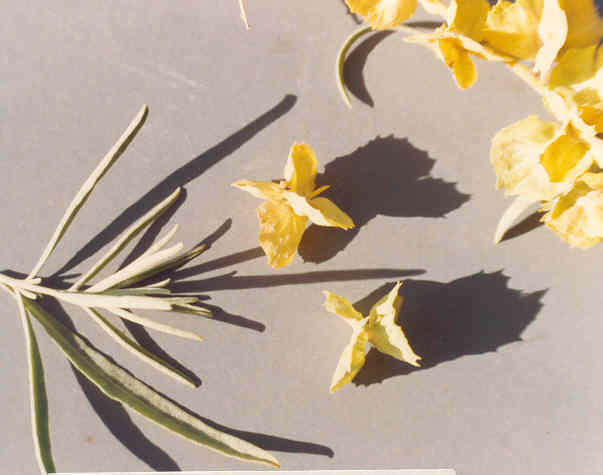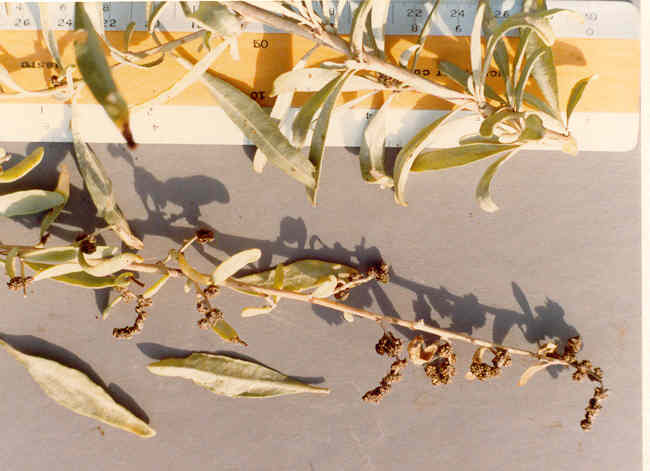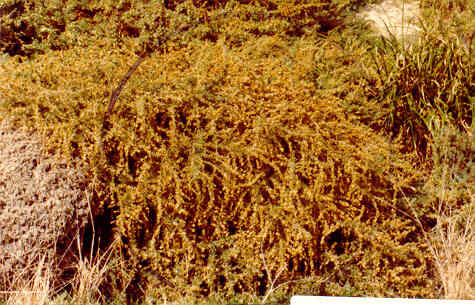
Atriplex canescens (Pursh) Nutt. ssp. canescens.
Chenopodiaceae (Goosefoot Family)
Native
 |
Atriplex canescens (Pursh) Nutt. ssp. canescens.Chenopodiaceae (Goosefoot Family)Native
Four-Winged Saltbush |
January Photo
Plant Characteristics:
Erect much-branched woody shrub 4-20 dm. high, grayish-scurfy, with
spreading or ascending terete branches; lvs. linear-spatulate to linear-oblong,
sessile, 1.5-5 cm. long, 2-8 mm. wide, revolute; plants dioecious, the male
glomerules in terminal panicles of dense spikes, the female in dense
leafy-bracted spikes and panicles; fruiting bracts stalked, the body hard, not
compressed, the bracts 6-15 mm. long, 4-8 (-10) mm. wide, with a second pair of
longitudinal wings from middle of each bract, the 4 wings entire to deeply and
coarsely dentate, smooth or appendages; seed brown, 1.5-2.5 mm. long.
Habitat:
Common on dry slopes, flats and washes, below 7000 ft.; Alkali Sink,
Creosote Bush Scrub, to Pinyon-Juniper Wd.; both deserts; less frequent in
subsaline places; Coastal Strand to V. Grassland; cismontane valleys from San
Diego Co. n.; to e. Wash., S. Dak., Kans., Tex., Mex.
June-Aug.
Name:
Atriplex is the ancient Latin
name for these plants. (Dale 95).
Canescens, becoming gray.
(Jaeger 45).
General:
Common in the study area and very common on the North Star bluffs.
Photographed on the North Star bluffs and at Big Canyon.
One of the native halophytes found in Upper Newport Bay. (my comments). The Zuni Indians ground the roots and
blossoms and moistened them with saliva for use on ant bites.
(Clarke 211).
Chenopodiaceae species have been known to cause hay fever and asthma.
(Fuller 379).
Indians ground seed for meal and also used them as an emetic.
Leaves were sometimes eaten as spinach.
Zuni Indians in New Mexico stirred the ashes of Saltbush into the batter
of their water bread in order to change the color of the meal to greenish-blue.
White New Mexicans chew green leaves with a pinch of salt to relieve
stomach pains. (Sweet 17).
Over 100 species, the genus essentially cosmopolitan.
(Munz, Flora So. Calif.
352). Subspecies intergrade.
(Hickman, Ed. 503).
Text Ref:
Hickman, Ed. 503; Munz, Calif.
Flora 379; Munz, Flora So. Calif.
354; Roberts 18.
Photo Ref:
Dec 3 82 #2,4; June 4 83 # 10; July 1 83 # 10; Oct-Nov 83 # 10; Jan 4 84 # 9.
Identity: by R. De Ruff.
First Found: December 1982.
Computer Ref: Plant Data 214.
Have plant sample.
Last edit 6/6/04.
 |
 |
November Photo December Photo